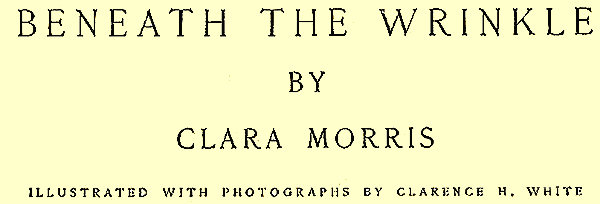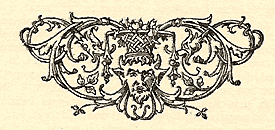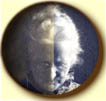“Beneath the Wrinkle” by Clara Morris. Photographic Illustrations by Clarence H. White
EFT by a careless maid, it lay upon the floor, a bit of faded, deeply wrinkled ribbon. I picked it up and, on the way to the waste-basket, I wondered aimlessly what its color had been and what its use; and as I walked, I smoothed it hard between my palms, for it was thick and the wrinkles deep -when from beneath the deepest fold of all there glowed a streak of full rose-pink. In a moment I had recalled a fair spring day, a crowded store, a dainty French hat, all frothing with white lace, wreathed with pale wild roses, and, for a coquettish looping beneath the left ear, two rose-pink ribbons. This was the ghost of one of them.
I smiled in happy recognition, but I could not yet cast it away. The pallid, wrinkled thing — what was it trying to remind me of?
Faintly, old memories seemed to be stirring. Not dear, precious memories – guarded carefully, placed securely where they may be found on the instant; but poor old memories, pushed back, far back into the dark corners, on the high shelves of my brain. I stood staring hard and whispering to myself: “So old – so faded, yet beneath the wrinkle such a lovely streak of color” and then, right in a second’s flash, I saw before me a face – pallid, faded, care-worn – where fifty years had wrought the lines of seventy. The eyes dim, the lips pale; but beneath the wrinkles — was there any color there? I straightened out the ribbon gently and shut it in a book – I’d call it a marker. I could not cast it away, for it was to me a veritable daguerreotype of old Hester Tyler, whose sad, worn, faded face it had summoned before me.
I knew her well, old Hester, and just at first I used to be afraid of her. She was so silent and she worked so desperately. She was lean and hard and wrinkled. She rose by candle-light – but her work was never done. She was housekeeper for an old bachelor brother and an old, old mother, and she was the bond-slave of a mortgage. She toiled early and late inside the house and outside in the garden. She went nowhere – she saw no one. She read nothing but the Bible- that, she pored over on Sundays.
At the top of the steep, unpainted stairs, directly under the sloping roof-freezing in winter, scorching in summer- was her room, and there she had gathered her treasures. There were three. This woman of over fifty years had received in her whole life but two gilts. They and a small Bible – she had won it as a school prize in her far-away youth – were her most precious possessions. The gift that had come from her father interested me greatly. It was a small hair-trunk. It was piebald – white and sorrel – and I always expected to see it kick when she sat down on it. It was a very florid article and had the letters “H. T.” on top in large brass-headed nails.
The other gift was a very different affair – it was a daguerreotype, the closed case fastened by a small brass hook, and the pictured face within was the touch of color, rosy-pink and warm, left beneath the pallor and the wrinkles. For when old Hester had been young Hester, Love, standing in her path one day, had turned and walked beside her for a time, and she had found God good and the world fair. Then the tempest came and struck them down, and he rose up no more, while she walked on her way alone, and the years slowly turned her into the old Hester that I knew.
She had been a pretty girl – rosy, bright, and light of foot-when, owing to a temporary embarrassment in money matters, Louis La Farge came down to Bedford village to teach school through the winter months. He was young, well-looking, well-educated, and, before settling down to business, his father had given him two years’ grace in which to travel and see a little of the world. In those days remittances from home did not always arrive with precision and speed; so that a reckless, generous, or a careless man was very apt to be caught now and then, as La Farge had been, in a strange land, with the empty pocketbook that presages an empty stomach.
Glad of the employment, though amused at its novelty, La Farge worked hard and accomplished wonders in his school. Undoubtedly Hester Tyler was his best pupil, though she had only attended, that winter “for fun.” When her ambition had been aroused, she, to use a villager’s expression, “had turned to and worked like Cain!” Then the teacher had formed a small class of four, to whom he proposed to teach his native language –French- and before long Hester found that, to save her life, she could not look her teacher full in the face while conjugating the verb aimer; and after that it was surprising how much help he thought she needed in that study.
Often they were seen walking side by side to or from the school-house
, he holding a certain written exercise in his hand which he scrutinized carefully (while the passer-by was in sight), and Hester bending her studious glance upon her open French grammar. And so they trod the sweet, old, bewildering maze, whose paths have been worn clear and smooth by countless lovers’ feet, and found, at last, the temple where they made their vows, each to the other, and came forth promised man and wife; for love had made them so deaf and blind, they had seen nothing, heard nothing of the rising storm that was now about to break upon them. It seems almost impossible that there ever was a time when the word “foreigner” was a mere term of contempt, when a German was a “Dutchman” or a “Dutchy,” and a Frenchman a “Mounseer ” or a “Frogeater.” Wealth, manner, refinement made not the slightest difference: a “foreigner” was a person to sneer at, to jeer at, or to suspect. Particularly was this the case in the country, or in small country towns, where the people were narrow and ignorant.
Now, while Louis La Farge was immensely liked by the young people of Bedford, the older people had always frowned upon the upstart Frenchman; one man, indeed, taking his son indignantly out of that small class of four who wished to study French. But while being a foreigner was bad enough, poor La Farge was something far, far worse in their eyes– he was a Catholic.
Just at that time there was the bitterest possible feeling between sects. A wretched book was in circulation among the common people, a clap-trap, sensational, escaped-nun sort of a tale, making a malicious, inconsequent attack upon the Catholic Church.
Its absurdities were implicitly believed, and hatred and fear of Catholics were the result; therefore, when young La Farge courted Hester Tyler, the whole village stood aghast! Her mother indignantly refused to hear him out when he came to ask for Hester’s hand. He offered to give up his native land for love of her, and settle in the near-by city, that her family might watch over her welfare. His answer came in threats of bodily harm from her brother.
The old parson of the village church was his friend and tried hard to serve young Louis when he found he could not retire from the field and leave his sweetheart. Letters of warning were soon followed by letters filled with cruel threats of violence. Hester grew sick with fear for her lover’s safety. His remittance had come long ago from his home in France, and at last they determined they would elope; but, ever thoughtful for the welfare and the honor of his beloved, he coaxed his friend, the parson, to marry them in his house before they fled, and the next day they would be remarried in the city by a priest of his church. All was arranged – the minister kept his windows darkened that no one might happen in.
Pretty Hester, upstairs under the slanting roof, with trembling fingers fastened the white gown she had made in secret, for she felt she simply could not be married in colors; then, pinning the pretty gown up carefully about her, she slipped over it a dark skirt and circle cloak, and with her Louis’s daguerreotype, her small, honorably won Bible, and two dollars berry-money as her whole dot and furnishing for her new life, she stole out of the front door
– that door which only opened for weddings or for funerals, and, on swift young feet, fled through the lanes where long brambles caught at her and held her by the skirts; fled across the fields where small furry creatures scurried across her path; but, swiftly as she ran, Superstition kept pace with her, and she noted every sign of evil – even glancing up and marking that the pale young moon appeared to her over the unlucky shoulder -the moon that, like a tiny boat, rode over the waves of ink-black clouds or was for a time buried beneath them.
And when, all hot and breathless, she reached the small parsonage and stood waiting for the opening of the door, from the dim distance there came to her the dismal howling of a dog; a common enough sound at nightfall to this country girl, but this night was not like other nights, and she wished she had not heard it. To her first question on entering: “Has he come? Oh, has he come?” she received a smiling negative and the reminder that she was “ahead of time.”
Then the minister’s wife helped to unpin the white gown, smoothed it down, brought a flower for the girl’s hair
-and then they waited.
To the minister, who knew well that extreme impetuosity was the main fault of Louis La Farge’s character, his tardiness was disquieting in the extreme.
The hour struck – still they waited, while blushing expectancy changed to surprise: waited, while surprise changed to annoyance, and annoyance to mortified anger–aye, waited until fear grew into terror!
When the clock had three times struck the hours of bitter waiting, there was a consultation. Could Hester enter her home again without discovery?
She thought she could, as all were heavy sleepers there; and she had, of course, left the front door unfastened.
“The dog?” suggested the old lady – but Hester felt she could easily quiet his friendly recognition. And so it came about that the bride-expectant crept back un-wedded to her home.
The old minister held her icy hand, and led her stumbling, like the newly-blind, along the way her racing feet had brought her in the early darkness. With a gesture she quieted the dog, who came joyously to greet her. He stood looking at her a moment in perplexity, then sniffed about her, and finally reared up, and, with his paws upon her chest, looked into her eyes and whimpered uneasily. Hester took his rough head between her hands and spoke for the first time during that walk, and said slowly: ” Yes, Watch – he’s dead! “
At which the kindly old man at her side exclaimed: “But, my dear–my dear.–we-“
But she broke in drearily; “What power could keep him away from me, if he were alive? No – my Louis is dead! “
She put the dog from her and, without another word, went up the walk, softly opened the front door, and disappeared.
When Hester Tyler took her place at the breakfast table next morning, her face was positively ghastly. In answer to questions she muttered something about “having had a bad night.” She scarcely seemed to see what was before her, or to hear what was said; yet, had she been watched closely, it would have been seen that she was listening for something with her very soul!
Her brother had gone to his work, and she was silently attending to her regular duties in the house when it came! – the thing she had listened for! The tramping of feet-the excited voices! She stood stock-still, and for a moment felt that she swung in space! Then, holding tight and hard to the back of a heavy chair, she heard the words
-“Carry him in here till you can mend the wagon” –separate themselves from other words; and knew the front door was being opened–the door that only opened for marriages and deaths!
She felt the jarring of the floor beneath her feet, that told of the heavy stepping of men in the next room – men who bore a burden-then all was still in there. Her mother, sister, brother, were outside listening to the tale of the finding of Louis La Farge’s body, clothed in his best, wearing a white neckerchief, and on one hand a white glove-the other lay on the ground near him – while down between the finely crimped ruffles of his shirt the blood had run from the knife thrust in his breast. There was no trace of a struggle; he had evidently been attacked by some one in hiding in the thick undergrowth and bushes at the roadside; and at the nearest house a dog, early in the evening, had howled and howled until its owner had gone out and threatened him into silence.
Poor Hester must have heard it as she waited for the opening of the parsonage door, and now, while those outside talked and tinkered at the broken wagon wheel, she swiftly entered the darkened front room where her love awaited her. She gazed long at the chill white face, that she saw for the first time without a smile. He was stretched at rigid length upon the sofa, and she knelt down beside him and laid her head upon his breast, and, with her arm about his icy throat, she whispered into his dull ear, calling him ” husband,” and promising to be true always until they met again – and gave him warm kisses her girlish modesty and proud self-respect had denied to his strong pleading. And then she rose and looked long again, kissed him on his brow, turned, crept up the steep stair, gained her room, and never knew when the still body was carried out again and taken on to the village.
The mystery was never solved. His parents sent money for a headstone; and in his cold breast he held the flower of Hester Tyler’s youth.
She almost lost the faculty of speech, so silent she became. Her sister married, her brother involved himself in business trouble, a mortgage was suspended over the old home, the mother grew crabbed in her old age.
Hester worked early and late, and faded and wrinkled fast, and so came to be the old Hester Tyler that I knew
; but on Sunday afternoons, up under the sloping roof, she reads the little Bible slowly, then kneels beside the open hair-trunk and looks long and tenderly at the bright, dark, smiling face the daguerreotype holds, for that is the one single trace of lovely color which life has left beneath her pallor and her wrinkles.
Click on a choice below to continue the exhibition. Or click here for the Museum’s home page.
Compare and decide: Was the photographer’s best work cut from the published story?
Thanks to Terry Pochert of Connert Media, Inc. for technical assistance. Enhanced digital images, new art, and interactive version: Copyright © MMIX The American Photography Museum, Inc. All Rights Reserved. American Museum of Photography and the Logo are Trademarks of The American Photography Museum, Inc. Web Development: Becker Information Group, L.L.C.




